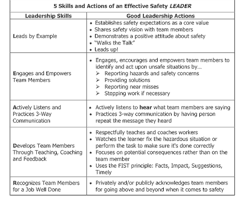Construction Safety: Does Safety Leadership Training Make Sense for Your Business?
As we all know, construction work is responsible for hundreds of fatalities and thousands of work-related injuries and illnesses each year. As the head of the OSHA Directorate of Construction, Jim Maddux dealt with a number of preventable, deadly incidents:
- A foreman operating a backhoe sends a worker into an unguarded trench. The water-soaked soil collapses, killing the worker before emergency crews can rescue him.
- A contractor is working on Super Bowl Sunday, rushing to meet a deadline. One crew is purging gas lines for the new electric generation plant. Nearby, gas space heaters are keeping workers warm. Workers are welding and performing other spark-producing work. The explosion kills six workers and destroys the facility before it produces its first kilowatt.
- A parking garage is being built using prefabricated panels. Grout wasn’t properly installed at the ground floor. The project manager, foremen and a dedicated inspector either didn’t notice or didn’t say anything about it. Four workers die when the structure collapses.
To help prevent incidents like these and others, construction owners and general contractors increasingly are looking for contractors and subcontractors with outstanding safety programs.
Many construction contractors, especially larger ones, who have implemented formal safety and health management systems to deal with the hazardous nature of the work, report success in reducing hazards, injuries and fatalities. Typical of these structured programs is the recognition that safety leadership from management – including business owners, project managers and supervisors – is key to that success.
Construction contractors, the building trade unions and safety researchers also are recognizing there’s another key to success: the importance of having foremen, lead workers and other front-line supervisors practice safety leadership skills on the job site. Because these individuals are responsible for effectively communicating the company’s safety policies and procedures to workers, they are the linchpin to safety program success.
Safety Climate
Research tells us that worker perceptions of how well safety policies, procedures and practices are implemented on the job site, also called Safety Climate, is key to improving safety outcomes. Foremen and lead workers play a key role in creating a strong job site safety climate by being good safety role-models and effectively communicating safety expectations during their daily interactions with workers.
Practicing safety leadership skills has shown the potential to help construction firms improve their safety and health programs and reduce the human and economic consequences of workplace incidents. Unfortunately, there is a shortage of safety leadership skills training in the construction industry that could help employers reach their safety goals.
To help address the gap, CPWR - The Center for Construction Research and Training developed The Foundations for Safety Leadership (FSL), a safety leadership training module designed to enhance foreman and lead workers’ understanding of the importance of safety leadership and skills to put them into practice.
There were two key drivers that led CPWR to recognize the need for such training. First were findings from a 2012 McGraw Hill (now Dodge Data Analytics)/CPWR survey showing that many construction companies, regardless of size, require their newly promoted foremen to take the OSHA 30-hour course to learn leadership skills, which up to now has not been part of the course. The second was discovered at a 2013 CPWR/National Institute of Occupational Safety and Health (NIOSH) workshop. Seventy stakeholders from the construction industry worked together and concluded there were eight key leading indicators of a positive safety climate in construction, one of which was site supervisor safety leadership.
The FSL module, which was approved for use by OSHA earlier this year, is the result of a rigorous development process. Under the direction of Dr. Linda M. Goldenhar, director of Research and Evaluation at CPWR and researchers from the University of Colorado Boulder and the Center for Health, Work & Environment at the Colorado School of Public Health with expertise in leadership, a multi-disciplinary curriculum development team was convened that included OSHA 10- and 30-hour outreach trainers, construction workers, safety and health professionals from small and large companies, representatives of building trade unions, consultants and government officials.
Five Leadership Skills
The curriculum development team agreed on five safety leadership skills that they believe all foremen and lead workers’ need to practice if they want to be effective safety leaders, which are:
There are many benefits that can come from foremen and lead workers put these skills into practice including:
- Increased morale
- Increased teamwork
- Positive safety climate
- Reduced hazards
- Better quality work
- Reduced family and co-worker suffering
- Better business reputation
- More productive workforce
- Reduced insurance premiums
- Fewer injuries and illnesses
- Fewer work stoppages to conduct incident investigations
The potential benefits of using the Foundations for Safety Leadership module greatly outweigh the small costs of conducting the training; there is no cost to downloading the materials from CPWR https://www.cpwr.com/foundations-safety-leadership-fsl. In fact, in addition to providing the FSL training to all current and newly promoted foremen and lead workers, others also may benefit from the course materials, including higher-level managers, project engineers and human resources professionals.
“After the training, we had one issue where something probably would have gone not corrected, except for the fact that one of the workers brought it up to the foreman and the foreman gave them exact explicit direction on how to correct it, and it got done right away, said Richard Coakley, corporate safety director, Gaston Electrical Co.
For contractors, providing safety leadership training to employees can improve the safety program, reduce the human and business consequences of workplace incidents and show a commitment to construction safety.
“I think the crew is more willing to bring up items to the foreman… I know that we have had guys bring stuff up that matters, and we've actually made changes on site or brought it to the attention of people who can make changes because of what our guys are bringing up,” said Ray Grosshans, president of Panel Masters
Leadership training allows foremen and lead workers to learn ways to handle safety responsibilities more effectively, engage work crews in safety matters and improve success as a lead worker or foreman.
As one foreman said: “The biggest thing I took out of it – and it’s something that I’ve always done but never took it as seriously as I do now – is that three-way communicating. Instead of just giving somebody some information, sending them off blindly to do the job and then getting mad ‘cause they didn’t do it right, they can explain to you exactly what you said to them. If they didn’t get it the first time, you can talk about it, have an opportunity to get it right. And it also makes them feel like they’re part of the planning.”
“I pulled everybody together at lunch and told them what my lead did for going above and beyond for safety, pulling [a worker off a lift] because he didn’t have fall protection,” noted another foreman/lead worker. “That gave him reassurance that what he did was right and gave him props. Everybody else recognized that at the same time. We get to do that more as people are being more aware of their surroundings and the dangers around them.”
The construction industry has said loud and clear that ity wants its foremen and lead workers to have the skills needed to be effective job site safety leaders. As one trainer noted, “During my introduction, I ask what is MISSING from the OSHA 30. Everyone's eyes light up when I say: ‘How to communicate effectively. How to lead.’ Everyone gets it. During [a training session] we had a fantastic conversation about three-way communication, and how to make it natural and not offensive, and how to ask clarifying questions as a way to achieve the same goal. Everybody got something out of it, including this experienced trainer.”
(Author’s Note: Funding for the Foundations for Safety Leadership (FSL) training module came from CPWR - The Center for Construction Research and Training, as part of their five-year cooperative agreement with NIOSH. The FSL curriculum including Power Point presentation, animated videos, instructor guides and student materials are free to anyone who wants to use them. You can download them from the CPWR web site. If you want additional information about the module or have questions, please contact Dr. Linda M. Goldenhar at [email protected].)
About the Authors: Jim Maddux retired from OSHA in 2016, where he was director of the OSHA Directorate of Construction. Before being appointed to the construction position in 2010, Maddux held several leadership positions at OSHA, including director of the Office of Physical Hazards, the Office of Maritime, the Office of Biological Hazards and acting deputy director for the Directorate of Standards and Guidance. Maddux has been a project director, author and contributor to numerous OSHA standards, guidance, enforcement and outreach projects. Topics include cranes, communication tower safety, personal protective equipment, pandemic influenza, injury and illness recordkeeping, ergonomics, motor vehicle safety, hearing conservation and maritime safety issues. He was a major contributor to the OSHA/NIOSH/CPWR fall prevention campaign and stand-down. Maddux has a bachelor’s degree in economics, an associate degree in computer information systems and an associate degree in chemistry. He provides consulting, training, curriculum development, public speaking and executive coaching services to public and private sector clients.
Dr. Linda M. Goldenhar received her PhD in Public Health and began her career in occupational safety and health as a research psychologist at NIOSH. While there, she focused her research on a variety of construction-related issues including tradeswomen’s safety and health concerns, worker perceptions of the ideal amount of overtime and others. Goldenhar currently is the director of Research and Evaluation at CPWR, where she is the lead investigator on project creating leadership training for frontline foremen and supervisors (Foundations for Safety Leadership (FSL)) and also the lead on CPWR’s Safety Climate efforts. She has published over 65 peer-reviewed publications, numerous articles in trade magazines and written book chapters and manuals. She has presented her work at many national and international academic and construction-specific conferences.

